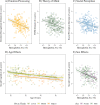Metabolic disturbances, hemoglobin A1c, and social cognition impairment in Schizophrenia spectrum disorders
- PMID: 35668078
- PMCID: PMC9170776
- DOI: 10.1038/s41398-022-02002-z
Metabolic disturbances, hemoglobin A1c, and social cognition impairment in Schizophrenia spectrum disorders
Abstract
Social cognitive impairments are core features of schizophrenia spectrum disorders (SSD) and are associated with greater functional impairment and decreased quality of life. Metabolic disturbances have been related to greater impairment in general neurocognition, but their relationship to social cognition has not been previously reported. In this study, metabolic measures and social cognition were assessed in 245 participants with SSD and 165 healthy comparison subjects (HC), excluding those with hemoglobin A1c (HbA1c) > 6.5%. Tasks assessed emotion processing, theory of mind, and social perception. Functional connectivity within and between social cognitive networks was measured during a naturalistic social task. Among SSD, a significant inverse relationship was found between social cognition and cumulative metabolic burden (β = -0.38, p < 0.001) and HbA1c (β = -0.37, p < 0.001). The relationship between social cognition and HbA1c was robust across domains and measures of social cognition and after accounting for age, sex, race, non-social neurocognition, hospitalization, and treatment with different antipsychotic medications. Negative connectivity between affect sharing and motor resonance networks was a partial mediator of this relationship across SSD and HC groups (β = -0.05, p = 0.008). There was a group x HbA1c effect indicating that SSD participants were more adversely affected by increasing HbA1c. Thus, we provide the first report of a robust relationship in SSD between social cognition and abnormal glucose metabolism. If replicated and found to be causal, insulin sensitivity and blood glucose may present as promising targets for improving social cognition, functional outcomes, and quality of life in SSD.
© 2022. The Author(s).
Conflict of interest statement
SXT is a consultant for Neurocrine Biosciences and North Shore Therapeutics, received funding from Winterlight Labs, and holds equity in North Shore Therapeutics. RWB is a DSMB member for Merck, Newron, and Roche; on the advisory board for Acadia, Avanir, Boehringer Ingelheim GBMH, GW Pharma, Minerva, and Roche; and consultant for Boehringer Ingelheim GMBH. AKM is a consultant for Acadia Pharmaceuticals, Genomind Inc, Informed DNA, and Janssen Pharmaceuticals. The other authors have no disclosures to report.
Figures




References
-
- Oliver LD, Haltigan JD, Gold JM, Foussias G, DeRosse P, Buchanan RW, et al. Lower- and higher-level social cognitive factors across individuals with schizophrenia spectrum disorders and healthy controls: relationship with neurocognition and functional outcome. Schizophr Bull. 2019;45:629–38. doi: 10.1093/schbul/sby114. - DOI - PMC - PubMed
Publication types
MeSH terms
Substances
Grants and funding
LinkOut - more resources
Full Text Sources
Medical

